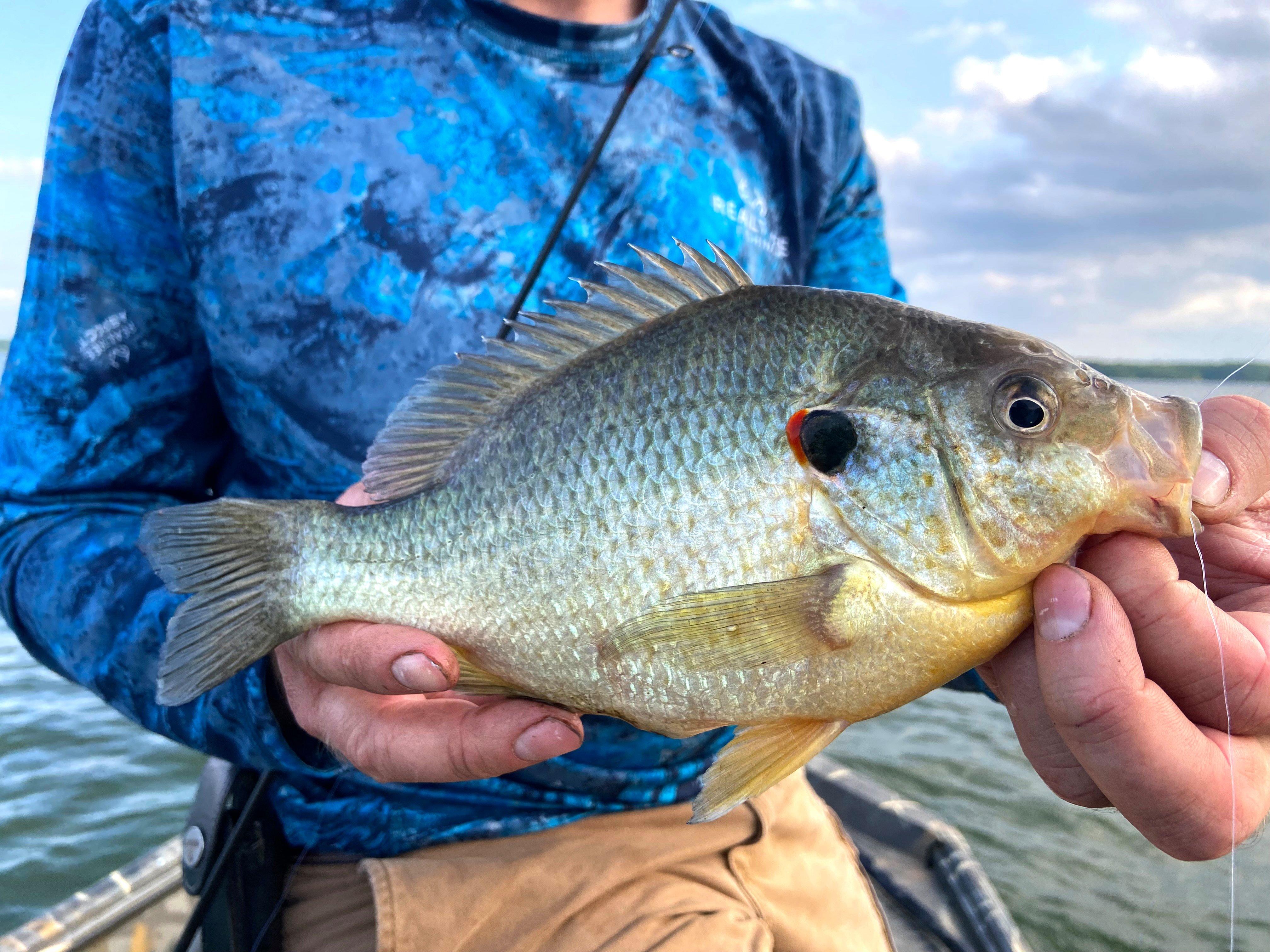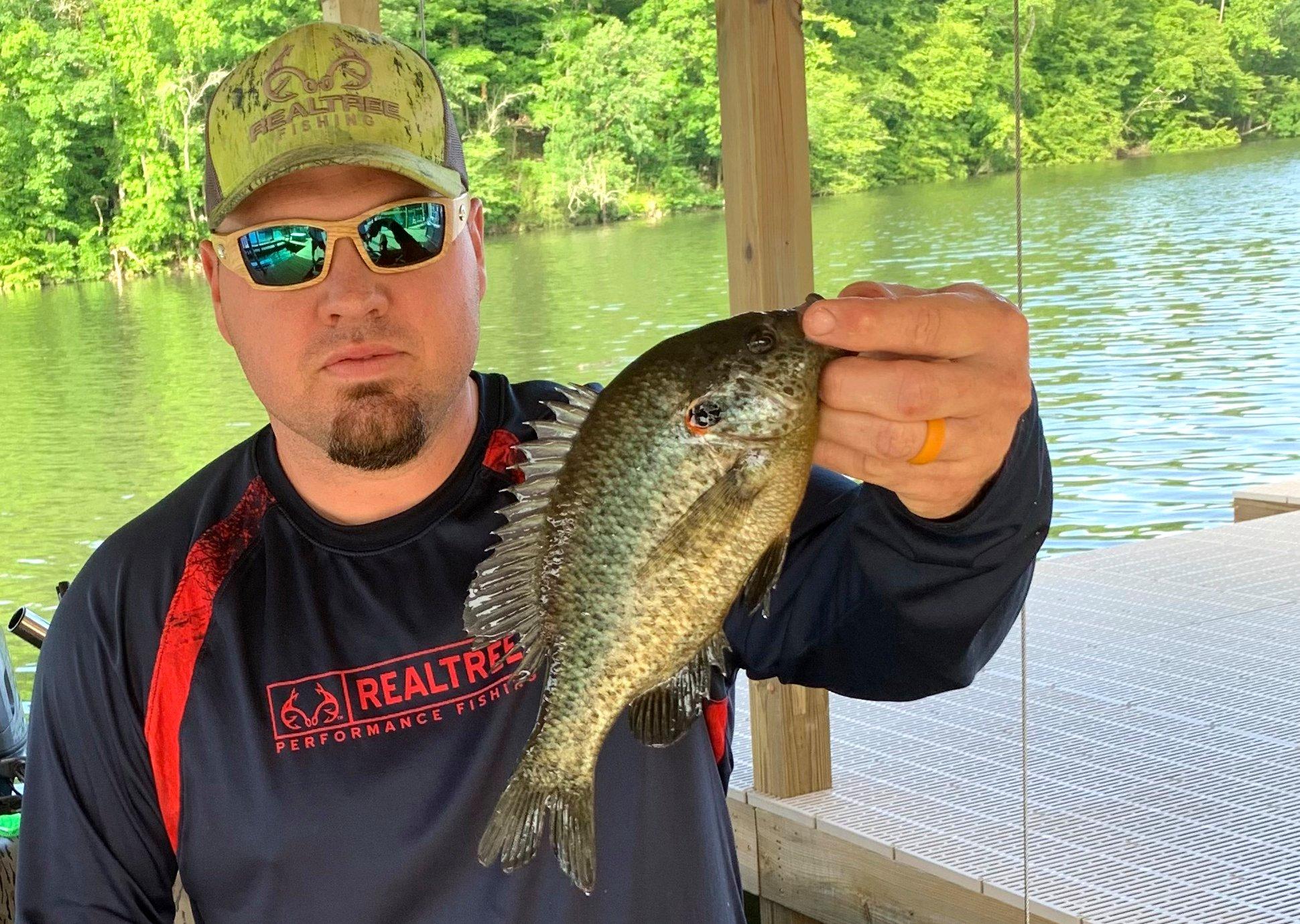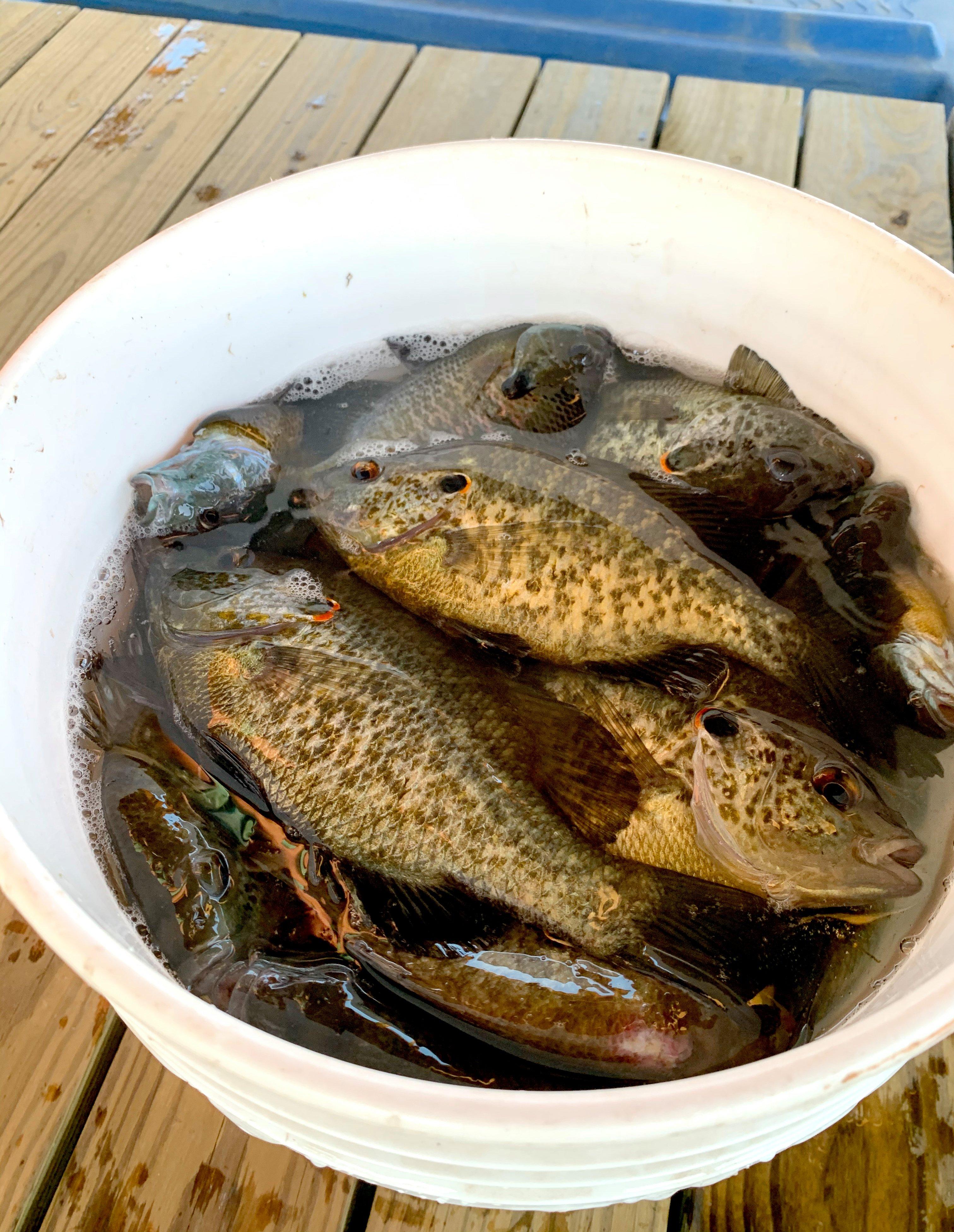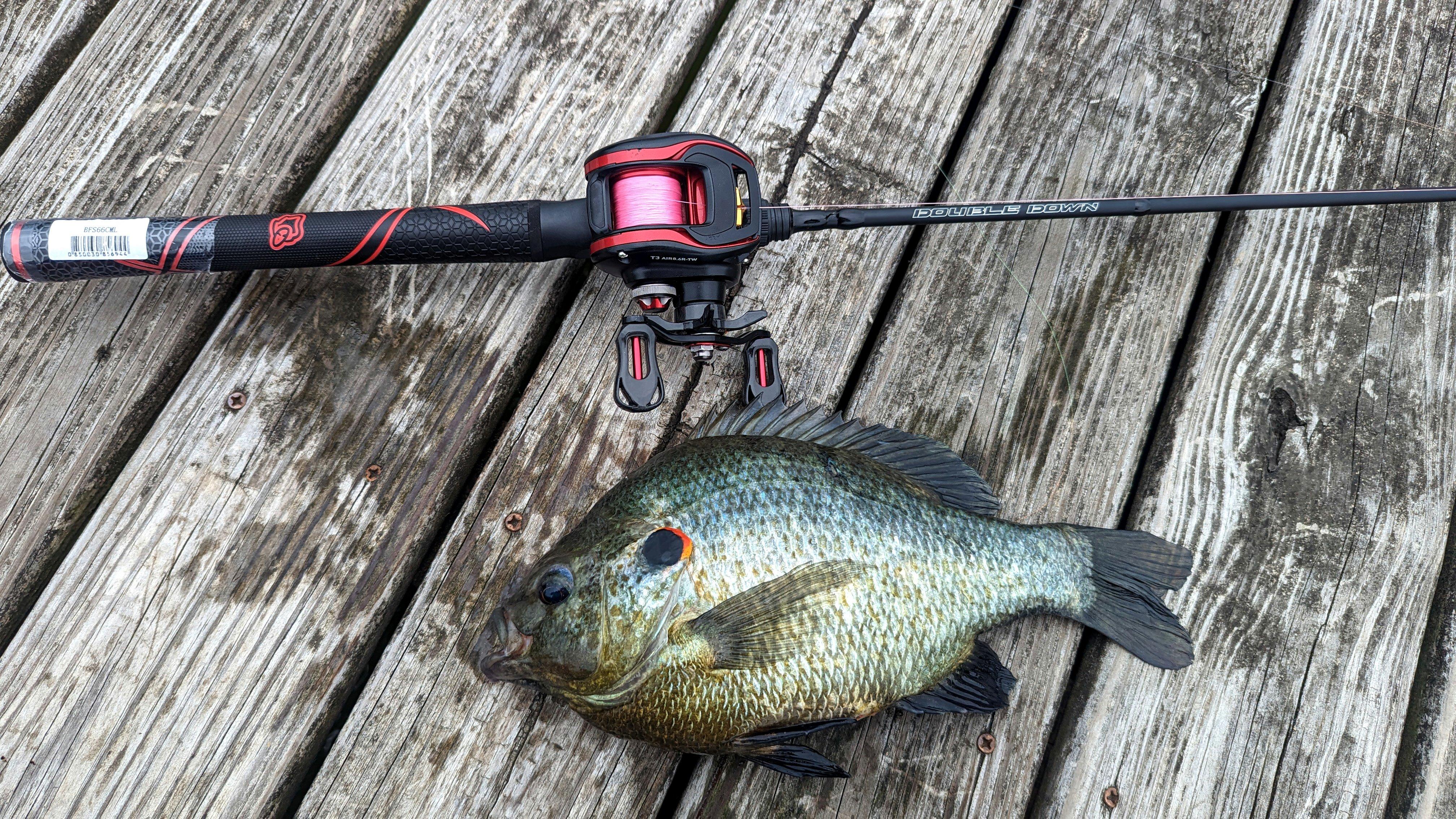Redear sunfish are the biggest bream in the South, and famous for being finicky. Here’s how to catch more of them in the late spring

Redear sunfish, usually called shellcrackers, get big and put up a fight. Image by Michelle Brantley
The first shellcracker of the year you catch will be the biggest panfish you’ve ever seen … or at least that’s what Will Robey says. Robey is the operations manager for Jenko Fishing, and though he fishes the Cumberland River just about year-around for whatever will bite, the redear sunfish — usually just called a shellcracker by those in the know — is his favorite species. That’s partly because they all look huge after a long winter away from bream fishing (even though, in reality, some are much bigger than others).
“They grow to such crazy proportions compared to a bluegill, and they pull so unbelievably hard for a freshwater fish, that it’s something of a shock every spring when you finally catch them again,” Robey says. “Pound for pound, I think they’re the hardest fighting freshwater fish that swims.”
Because the typical keeper-sized redear will be 11 inches long and weigh close to a pound — and because true 2-pounders aren’t uncommon — they do look a little freakish when you’re accustomed to catching bluegills. That size, combined with a finicky reputation and table-fare quality that’s unmatched, makes shellcrackers a coveted species wherever they roam.

Realtree's Stephen McNelly with a Georgia shellcracker.
CLEAN SOUTHERN FUN
Shellcrackers are native to the southeastern United States, but they’re pretty adaptable and have been introduced to other fisheries outside of their native range. Some western desert lakes, like Havasu, turn out huge redears every season. You might catch a shellcracker in a farm pond, strip mine lake, or other small body of water, but the most consistent fishing for them happens in southern impoundments. Gentle flows of clean, clear water combined with rocky and sandy bottoms provide the best habitat for the mussels, snails, and other mollusks that shellcrackers feed on the most. That is, after all, where the name is derived.
Robey says understanding the seasonal movements of those mollusks is key to consistently catching redears. “For a big portion of the winter, shellcrackers live out on the edge of the river channel,” he says. “They’re in deep water, down in the little eddies where all the mollusks gather out of the current.”
Robey says the fish migrate to the shallows in the spring, but it’s an on-again, off-again transition. “Up in the shallow bays, there might be a 20-degree temperature swing in a week’s time,” he says. “They don’t like that. But when the water gets warm and stabilizes, you can walk the banks and start seeing little snails and things crawling up and attaching themselves to rocks in the shallows. You start fishing around and catch a redear here and there… that’s your cue that a big movement of fish is coming soon.”

With big fillets that taste like bluegill, shellcrackers are tops for a fish fry.
FEED BEDS
Many bream fishermen talk about finding big “beds” of spawning bluegills and redears. Sometimes that’s exactly what’s happening, too, when you catch multiple fish from the same general area, but not always. Robey says that shellcrackers in particular are notorious for feeding in spurts.
“You can get on a good spot and pound them, catching fish every cast,” he says, “and then all of the sudden, the bite quits. Sometimes people think they’ve fished a bed out, but a lot of the time, if you just kick back for 20 minutes, drink a pop or check your phone, they’ll start feeding again.”
Robey believes this is part of the normal feeding behavior for shellcrackers, which swarm snail beds to feed, eat until their guts are full, and then move back offshore to regurgitate the pulverized shells. “You can check some of those spots in the winter, when the water’s down, and see fine lines of white shell debris,” he says. “That’s where they’re spitting those shells out. It’s not showing you where they feed, but it is showing a spot that’s close to where they feed.”
REAL BEDS
Of course, sometimes you really are catching spawning shellcrackers “off the bed.” They are typically males that are guarding an established nest. It’s been said that shellcrackers usually nest in deeper water than bluegills, but Robey says that’s not universally true.
“Sometimes they are deeper than the bluegill, but I’ve seen them bedded in water so shallow their backs were almost out of it, too,” he says. “The constant with redear beds is the bottom content. They don’t want to bed in the mud. You’ll always find them where there’s very fine pea gravel or sand. They also like some sort of structure near the bed, like a rock or a log in the water, maybe for the security it provides. Bluegill will nest around that stuff, too, but they don’t do it exclusively.
(*Don’t Miss: *GUIDE TO SUMMERTIME TOPWATER BAITS)

Bait finesse systems allow for casting precision and better sensitivity. Image courtesy of Jenko Fishing.
TACTICS AND TACKLE
A good many bluegills are caught on a cricket under a bobber. That can work for shellcrackers, too, but a specialized presentation is more effective. Because they dine on mollusks, redears are accustomed to feeding on the bottom. Because of that, in Mid-South reservoirs, shellcracker anglers who know what they’re doing fish drop-shot rigs most of the time.
To prepare a drop-shot, tie your hook to the line with a Palomar knot, but leave a long tag end, which you then thread back through the hook eye. Next, tie a sinker (a 1/16-ounce casting sinker is preferred) to that tag end. There should be 6 to 10 inches of line between the sinker and hook. On a tight line, the presentation keeps the bait just off the bottom. It also allows for long casts and covering water.
“I fish a drop-shot with a red worm probably 70 percent of the time,” Robey says. “I like it because I can feel changes in the bottom structure, like a transition from sand to gravel. When your weight starts snagging up, signaling a rocky edge, that’s where you want to wait a bit. Shellcrackers love to work those edges.”
On occasion, finicky shellcrackers, especially those nesting in shallow water, will snub the drop-shot. When they do, Robey will switch to a light, clip-on balsa-wood float above a weightless hook tipped with a red worm. He says shellcracker anglers should be prepared for light strikes, whether they’re fishing with a cork or a drop-shot rig.
“That’s a big secret with redears,” he says. “All those times you’ve been fishing and felt the tiny peck-peck on your hook, and though it was little sunfish, a lot of the time, it’s giant shellcrackers. If you’ve ever watched underwater videos of them feeding, you’ll see that they will suck up a bite and spit it out a dozen times before committing to it. So, with the drop-shot, you’re just feeling for a slight tick. And with a cork, you’re rarely waiting for it to go under. It might just turn funny or lay on its side. When it does that I check, and if it feels heavy, I lean into it to set the hook.”
It's because of those light strikes, Robey says, that many shellcracker anglers just fish too fast. “Every cast is painfully slow,” he says, “not much faster than still-fishing for catfish. With that drop-shot, you cast it, move it a few inches, let it sit a while, and then move it a few more inches.”
Most bream anglers naturally gravitate to ultralight spinning gear, but Robey prefers a Bait Finesse System (BFS), which is a specialized ultralight baitcasting reel designed to throw tiny lures. His go-to reel is one of the Daiwa Air Series models, and he pairs it with a 6-6 Jenko Double Down rod, designed for the task. “Those setups allow you to throw extremely light tackle more accurately, faster, and farther than a spinning rod,” he says, “but the bigger advantage for shellcracker fishing is the sensitivity; it’s amazing how much you can feel with the reel in your hand than through the rod alone. Plus, they’re just more fun to use. Those reels have drag clickers that sing when you get a big shellcracker on.”
Robey rigs up with fairly heavy tackle — 10-pound braided main line connected to an 8-pound fluorocarbon leader, and he uses No. 8 baitholder hooks, which have heavier wire than the standard Aberdeen cricket hook. “Shellcrackers are big and strong, and I want to get them to my hand quickly,” he says. “Plus, you catch a bunch of incidental catfish when you’re redear fishing, and the heavier tackle means you’re not retying and straightening hooks half the day.”
Giant shellcrackers, plus bonus catfish and bluegill? Sounds like a good time to us.
(Don’t Miss: HOW TO CRAPPIE FISH WITHOUT A DEPTH FINDER)










